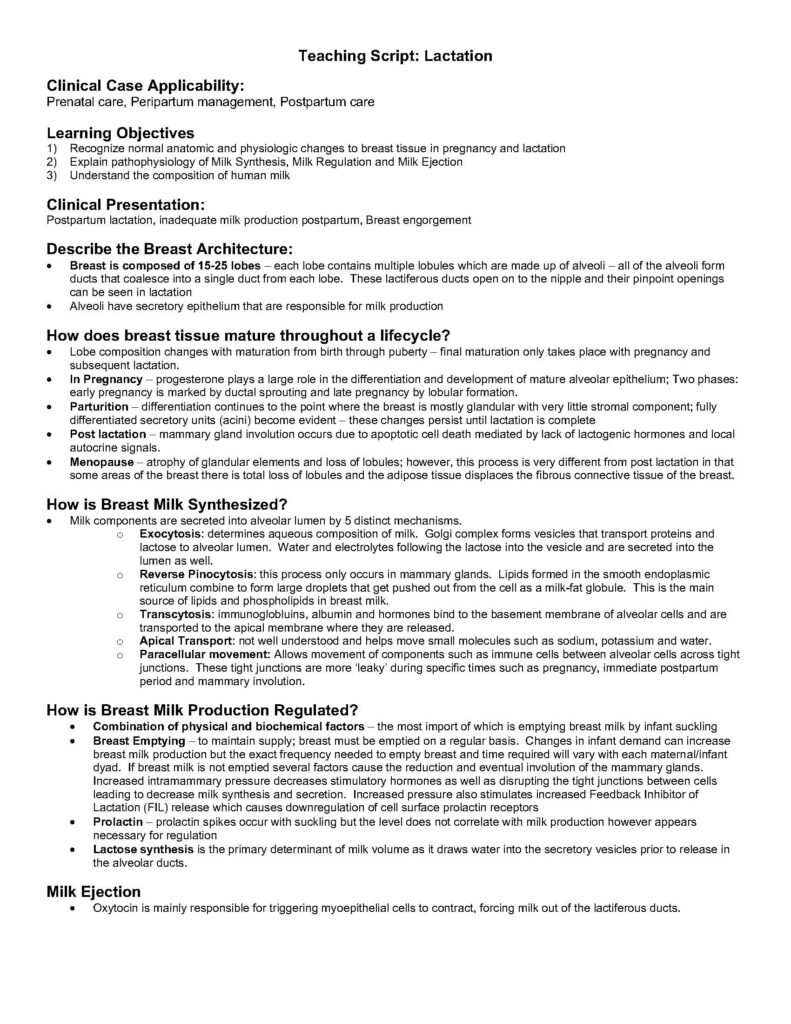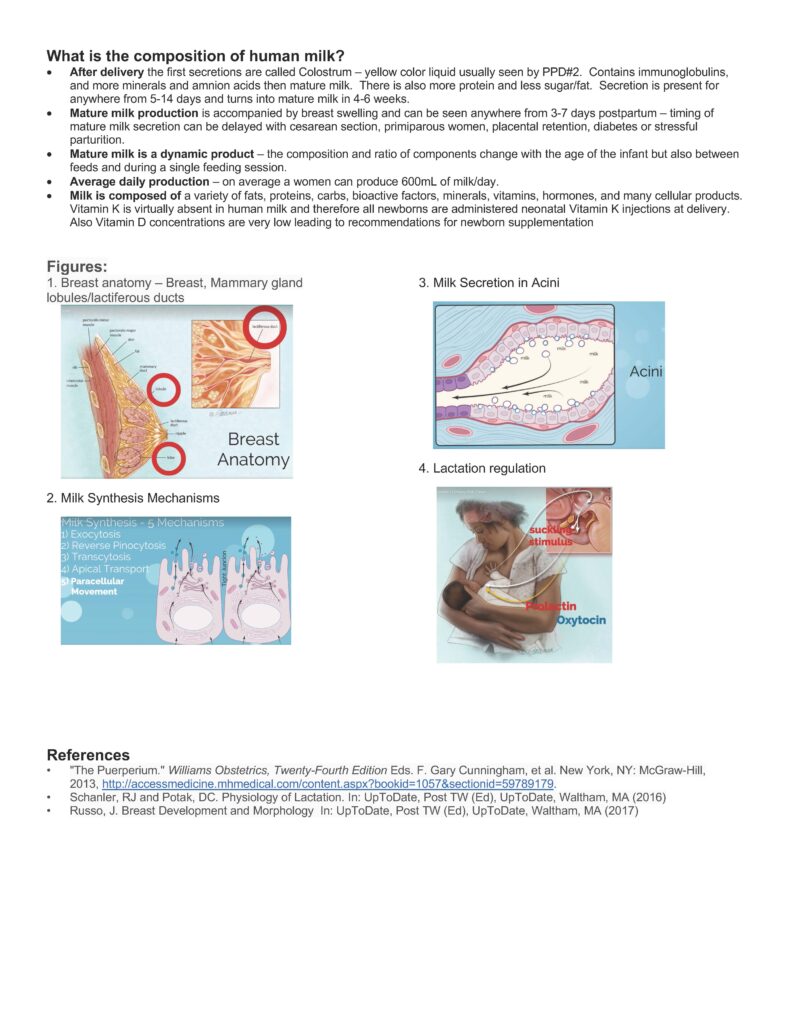Lactation
Duration 8:36
Teaching Script: Lactation
Clinical Case Applicability:
Prenatal care, Peripartum management, Postpartum care
Learning Objectives
1) Recognize normal anatomic and physiologic changes to breast tissue in pregnancy and lactation
2) Explain pathophysiology of Milk Synthesis, Milk Regulation and Milk Ejection
3) Understand the composition of human milk
Clinical Presentation:
Postpartum lactation, inadequate milk production postpartum, Breast engorgement
Describe the Breast Architecture:
• Breast is composed of 15-25 lobes – each lobe contains multiple lobules which are made up of alveoli – all of the alveoli form
ducts that coalesce into a single duct from each lobe. These lactiferous ducts open on to the nipple and their pinpoint openings
can be seen in lactation
• Alveoli have secretory epithelium that are responsible for milk production
How does breast tissue mature throughout a lifecycle?
• Lobe composition changes with maturation from birth through puberty – final maturation only takes place with pregnancy and
subsequent lactation.
• In Pregnancy – progesterone plays a large role in the differentiation and development of mature alveolar epithelium; Two phases:
early pregnancy is marked by ductal sprouting and late pregnancy by lobular formation.
• Parturition – differentiation continues to the point where the breast is mostly glandular with very little stromal component; fully
differentiated secretory units (acini) become evident – these changes persist until lactation is complete
• Post lactation – mammary gland involution occurs due to apoptotic cell death mediated by lack of lactogenic hormones and local
autocrine signals.
• Menopause – atrophy of glandular elements and loss of lobules; however, this process is very different from post lactation in that
some areas of the breast there is total loss of lobules and the adipose tissue displaces the fibrous connective tissue of the breast.
How is Breast Milk Synthesized?
• Milk components are secreted into alveolar lumen by 5 distinct mechanisms.
o Exocytosis: determines aqueous composition of milk. Golgi complex forms vesicles that transport proteins and
lactose to alveolar lumen. Water and electrolytes following the lactose into the vesicle and are secreted into the
lumen as well.
o Reverse Pinocytosis: this process only occurs in mammary glands. Lipids formed in the smooth endoplasmic
reticulum combine to form large droplets that get pushed out from the cell as a milk-fat globule. This is the main
source of lipids and phospholipids in breast milk.
o Transcytosis: immunoglobluins, albumin and hormones bind to the basement membrane of alveolar cells and are
transported to the apical membrane where they are released.
o Apical Transport: not well understood and helps move small molecules such as sodium, potassium and water.
o Paracellular movement: Allows movement of components such as immune cells between alveolar cells across tight
junctions. These tight junctions are more ‘leaky’ during specific times such as pregnancy, immediate postpartum
period and mammary involution.
How is Breast Milk Production Regulated?
• Combination of physical and biochemical factors – the most import of which is emptying breast milk by infant suckling
• Breast Emptying – to maintain supply; breast must be emptied on a regular basis. Changes in infant demand can increase
breast milk production but the exact frequency needed to empty breast and time required will vary with each maternal/infant
dyad. If breast milk is not emptied several factors cause the reduction and eventual involution of the mammary glands.
Increased intramammary pressure decreases stimulatory hormones as well as disrupting the tight junctions between cells
leading to decrease milk synthesis and secretion. Increased pressure also stimulates increased Feedback Inhibitor of
Lactation (FIL) release which causes downregulation of cell surface prolactin receptors
• Prolactin – prolactin spikes occur with suckling but the level does not correlate with milk production however appears
necessary for regulation
• Lactose synthesis is the primary determinant of milk volume as it draws water into the secretory vesicles prior to release in
the alveolar ducts.
Milk Ejection
• Oxytocin is mainly responsible for triggering myoepithelial cells to contract, forcing milk out of the lactiferous ducts.
What is the composition of human milk?
• After delivery the first secretions are called Colostrum – yellow color liquid usually seen by PPD#2. Contains immunoglobulins,
and more minerals and amnion acids then mature milk. There is also more protein and less sugar/fat. Secretion is present for
anywhere from 5-14 days and turns into mature milk in 4-6 weeks.
• Mature milk production is accompanied by breast swelling and can be seen anywhere from 3-7 days postpartum – timing of
mature milk secretion can be delayed with cesarean section, primiparous women, placental retention, diabetes or stressful
parturition.
• Mature milk is a dynamic product – the composition and ratio of components change with the age of the infant but also between
feeds and during a single feeding session.
• Average daily production – on average a women can produce 600mL of milk/day.
• Milk is composed of a variety of fats, proteins, carbs, bioactive factors, minerals, vitamins, hormones, and many cellular products.
Vitamin K is virtually absent in human milk and therefore all newborns are administered neonatal Vitamin K injections at delivery.
Also Vitamin D concentrations are very low leading to recommendations for newborn supplementation
Figures:
1. Breast anatomy – Breast, Mammary gland
lobules/lactiferous ducts
2. Milk Synthesis Mechanisms
3. Milk Secretion in Acini
4. Lactation regulation
References
• “The Puerperium.” Williams Obstetrics, Twenty-Fourth Edition Eds. F. Gary Cunningham, et al. New York, NY: McGraw-Hill,
2013, http://accessmedicine.mhmedical.com/content.aspx?bookid=1057§ionid=59789179.
• Schanler, RJ and Potak, DC. Physiology of Lactation. In: UpToDate, Post TW (Ed), UpToDate, Waltham, MA (2016)
• Russo, J. Breast Development and Morphology In: UpToDate, Post TW (Ed), UpToDate, Waltham, MA (2017)


